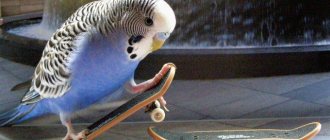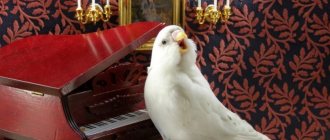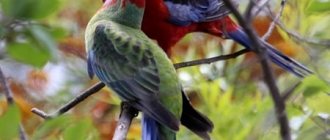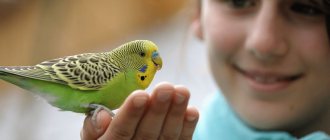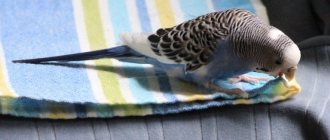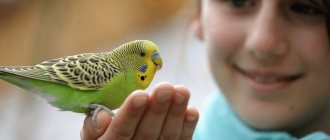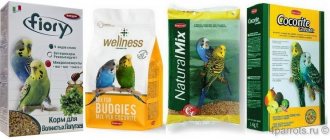In the article we will review accessories for parrots by type of purpose, consider what toys budgerigars love, and also analyze several basic principles of placement, selection and method of introducing the bird to them.
Nature has endowed parrots with curiosity and a desire to check everything around with their “beak.” You can leave your feathered pet to its own devices so that it can look for activities on its own, but it would be more correct to direct the pet’s talents in the desired direction. This is why you need all kinds of fun and accessories.
What types of toys are there for parrots?
Toys for parrots are designed not only to entertain your feathered pet. They help him develop intellectually and also maintain normal physical health.
Intelligent
We are talking about educational puzzles, the solution of which will lead the parrot to his favorite treat. Such toys contribute to the mental development of birds, which are already distinguished by their intelligence.
For sharpening the beak
Such toys are needed both for large parrots, for example, macaws or grays, and for medium-sized ones - cockatiels or necklaces, and also for budgerigars, lovebirds, etc. This is a mandatory attribute of the cell. They can be made from wood, plastic or paper. The main thing is the safety of the material, because the parrot will definitely swallow at least a small piece.
The use of such accessories will protect against damage to furniture and other interior items.
To maintain physical fitness
These are rings, bungees and ladders, perches located at different heights.
Interactive
Toys that require the bird to perform one or another action. In response to this, the toys reproduce any sounds that may interest the pet.
Store-bought or homemade toys
There are no strict restrictions in this matter. Accessories can be purchased in specialized stores. You can also make toys for parrots with your own hands. Sometimes the birds themselves suggest ideas for this, for example, by playing with plastic bottle caps or showing interest in threads.
Why do you need entertainment for your poultry?
Buying toys for your feathered pet seems like a minor and optional activity, but it is not. There are several reasons to equip a cage with a play space:
- Don't let the bird get bored in the absence of its owner.
- Do not let the bird from idleness spoil the interior of the room.
- Relieve a newcomer from psychological discomfort and speed up his adaptation to a new place.
- Keep wild birds in good physical shape at home.
A parrot is a bird that needs company, communication, it loves to play pranks and have fun. Otherwise, the bird begins to get bored and develops some psychological problems that can lead to illness. For known reasons, owners cannot stay near the cage with their feathered pet around the clock.
On a note! One of the main tasks of a good owner is to teach your pet to entertain itself on its own. For this, various gaming devices are needed.
The second reason is pranks. The budgerigar is a nimble, active bird capable of much. In just one evening outside the cage, he can tear off the wallpaper in the room, damage the wiring, climb into an outlet, or get tangled in the folds of curtains. The owners will not be able to monitor their pet every second. To prevent the wavy from being naughty in the room, they buy him toys.
The third reason is adaptation. As soon as the parrot gets into a new home, all the necessary conditions are created for it to quickly get used to the new environment. It is important that at this time the bird not only eats and drinks enough, but also does not get bored. Bright toys will help dispel melancholy and get used to a new home.
The fourth reason is obesity. Often, domestic parrots eat a lot and exercise little, which leads to health problems. Various swings and ladders will make your pet bird move more in a playful way. The parrot will not even understand that by jumping on ladders and playing with a ball, he burns off extra grams. Exercise toys are important for your budgie's health.
Harmless materials
Bird cherry, oak and pear branches are not suitable for making homemade toys for budgies and other parrots. It is also not recommended to use poplar wood. The pet will definitely taste the tree, and this can have a bad effect on its health.
It is better to stay on the branches of fruit trees. Before making anything, they need to be boiled.
When it comes to metals, you should not buy aluminum, brass, or zinc toys. Like unsuitable wood, they can harm your parrot's health.
Mechanical fastenings and hooks must also be secure.
Parrots love play accessories made from thread. It is better to take from linen, sesal, jute, cotton, etc. As soon as they become disheveled, they must either be replaced with new ones or completely removed from the cage.
Toys from scrap materials
To entertain your parrot in the absence of purchased toys, you can use natural materials. The cone of any coniferous tree is perfect for bird games. The parrot will not leave her until he thoroughly understands what is inside her. A garland is made from several cones strung on a thread and hung in the room. As soon as the parrot goes on a free flight around the apartment, he will be interested in this particular product. Wallpapers and books will be saved.
Branches of fruit and coniferous trees are also suitable for creating entertaining devices. You can create a swing using a short twig and hemp rope. Several branches, gathered in a bundle, tied with rope and suspended in a cage, will attract the bird's attention for a long time. In addition to the gaming function, they also perform a hygienic function.
On a note! The bird cleans and sharpens its beak on the strong bark of the branches.
Which ones should not be given?
For a budgerigar, like other species of these birds, you cannot buy painted toys. Small pieces of paint can enter the stomach, thereby causing poisoning.
Also, the accessories should not have holes in which the bird could get its beak stuck. It is better if the material used to make toys is durable, otherwise the parrot will be able to crumble it.
It is worth paying attention to the presence of sharp corners. During play, your pet may get hurt on them.
Why are Toys so important for our birds?
The topic of toys for parrots is no less important than topics about nutrition and feeding parrots.
Some owners can spend hours playing with their birds, teaching them to talk, sing, and whistle. But still, most owners work and their pets are forced to be alone for hours. What should a bird do during the time when it is alone and usually locked in a cage? Some birds become bored and lethargic, others begin to fiddle with their feathers (which turns into a very bad habit and often causes self-plucking). Funny toys are the answer to the above problems. By providing your bird with hours of entertainment and exercise, you can use toys to help keep your bird fit and healthy. As a pet in captivity, birds do not have the opportunity to fully do what they do in the wild. When observing wild parrots, it was noticed that after the priority of collecting food and sleeping, play time comes in second place. In the wild, parrots are very active and playful. They engage in stripping bark, biting off twigs and leaves, followed by tossing, swinging on vines and vines. And we should not forget that our pets in this regard are no different from their wild counterparts. Playing with toys is a vital replacement for natural behavior: foraging, nest building, and interacting with the flock. Toys perform several important functions:
– In young birds, playtime is part of a learning process in which birds begin to identify textures, colors and shapes. It also helps develop coordination and dexterity. Interacting with various objects at a young age helps the bird become self-confident. – Toys provide an outlet for natural aggression and the opportunity to expend energy through exercise. Toys can also help redirect aggression from owners to other objects. – Rotating toys improves mental health and gives the bird a sense of independence, making it self-sufficient. Birds equipped with many toys are less self-centered and exhibit less negative behavior, such as: self-plucking and self-mutilation, screaming when there is a lack of attention, fear of unknown objects, aggressiveness towards people, and damage to property.
Parrots focusing on themselves, without providing conditions for exercise, entertainment, and comfort, will lead to boredom, depression, and poor physical and mental health. The bird should have a wide variety of toys. It is also recommended to change them weekly to stimulate curiosity and prevent boredom.
Popular toys for budgies, cockatiels, lovebirds
So, what toys do small and medium-sized birds need? They are subject to a number of requirements. They should be bright, colorful, and noisy if possible. Birds are often very active. That's why they love it when everything creaks, rings, rustles, etc.
The following toys are suitable for small and medium parrots:
- Bells, rings, ladders, beads.
- Rattles, a Kinder Surprise “egg” filled with some kind of cereal. They will captivate the parrot for a long time.
- Beads made from plastic bottle caps.
It is recommended to place everything in the cage that can be dropped or thrown. If objects make loud noises, the bird will be delighted.
Toys for large parrots
Accessories for large birds, such as the macaw, are extremely difficult to find. But there is a simple way out - toys for children. The main condition is the environmental friendliness and safety of the material from which they are made. Also, all products must withstand the impact of a powerful beak.
Bells and musical toys
The most famous representative of this species is the classic budgerigar bell and all kinds of pendants with one or more bells. Various rattles can also be considered classics. But thanks to the progress that has reached pet supplies, more interesting options for interactive musical options have appeared. Their principle is based on the interaction of a bird with an object - the bird is required to press a button so that the toy makes a sound or melody.
There are also toys with a built-in motion sensor that responds to the movement of your pet. Unfortunately, most interactive musical products are designed for large birds, but you can also find unusual musical mechanisms for small birds.
Not available
Close
Drum
Rating
4.82 out of 5 53.00₽
Size: 4*4.5 cm.
Add to My Wishlist
More details
Quick view
Close
Bell with spoon, fork and knife
Rating
4.67 out of 5 RUB 264.00
Height 14.5 cm.
Add to My Wishlist
Add to cart
Quick view
Close
Hypnotic steering wheel for parrots
Rating
4.6 out of 5 RUB 376.00
Height 9 cm, width 6.2 cm.
Add to My Wishlist
Add to cart
Quick view
Close
Bell with stand-mount
Rating
4 out of 5 RUB 365.00
Height 7.5 cm, width 2.5 cm, depth 7 cm.
Add to My Wishlist
Add to cart
Quick view
DIY parrot toys
Toys for cockatiels, ringtailed parrots, budgerigars and representatives of large breeds can, of course, be bought in the store. But there is no guarantee that they are made of high-quality, safe material. Therefore, you can arm yourself with improvised means and make them yourself.
Swing
You need a wooden perch, several beads, and wire. A base in the shape of a triangle is made from wire. Its size depends on the size of the pet plus a few cm for securing.
Instead of a perch, you can use any tube that has a hole for wire or rope.
Bells
They can be hung individually or collected into one large toy. You can take a rope about 5 mm thick, a bell, a twig and beads. Tie knots on the rope, putting beads between them. Attach a twig (perch) and a bell from below. Hang from the top of the cage. You will get a so-called “bungee”.
Ladders
Both big and small birds like these toys. Making them couldn't be easier. You need poles of the same size and rope. At the ends of the poles you need to make indentations, thanks to which the rope will hold more securely. Wooden parts are sanded and bonded.
Rattles
What parrots love most are rattles used for teething. If desired, they can be additionally decorated with multi-colored beads.
Rope
They are placed in a room where the parrots can move freely. You need to attach hooks and handrails to the wall, and string ropes between them. After the bird has fed up, the structure can be disassembled.
Suitable plants for games
There are several options here:
- Willow wreath. To make it you will need a hard wire hoop and willow branches. Leaves can be left if desired. To decorate the finished toy, treats, flowers, small bells, etc. are used.
- Parrots are not averse to chewing flowers. You should be careful in choosing them. Under no circumstances should you give datura, laburnum, foxglove, holly and poinsettia.
- Birds love to play in greenery. It can be picked outside or grown at home in a pot.
Any plants that your parrot will play with should be thoroughly washed before use.
Mirrors: pros and cons
Parrots love to admire themselves. Sometimes they even talk to their reflection. Therefore, a mirror in a cage is simply necessary. A powder mirror is suitable for small birds.
How to place toys in a cage
Game items should be placed in the bird's housing in such a way that there is free space for movement. Don't take up useful space; hang a parrot swing and a couple of play accessories. If you fill the cage with new things without removing the old ones, then soon the bird simply will not have the opportunity to spread its wings.
The middle of the cage should be provided for the parrot to flutter from perch to perch. Hang toys from the top or side of the cage, but not from the perch, otherwise they will be constantly stained with droppings. Secure objects thoroughly so that they do not fall, and the bird itself does not fall during play.
Clue! Take a closer look at what things no longer delight your pet and hide them. When the bird has forgotten about these annoying toys, you can place them back in the cage.
A new craft should not be immediately attached to the rods: the parrot may experience fear at the sight of an unusual object. First, play together outside the house. Praise and offer treats to your bird for every attempt to approach an unfamiliar thing.

